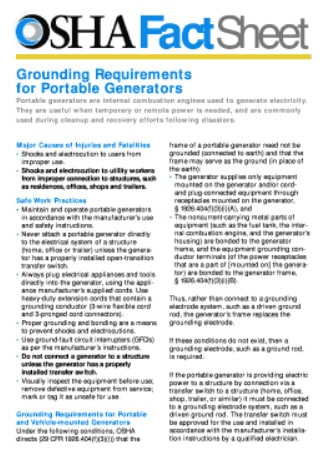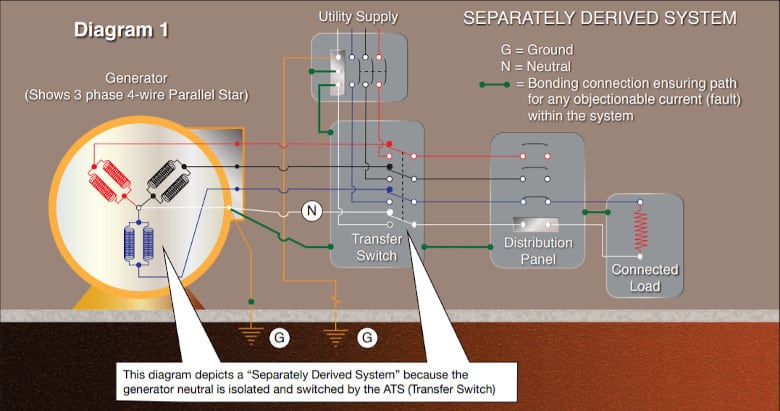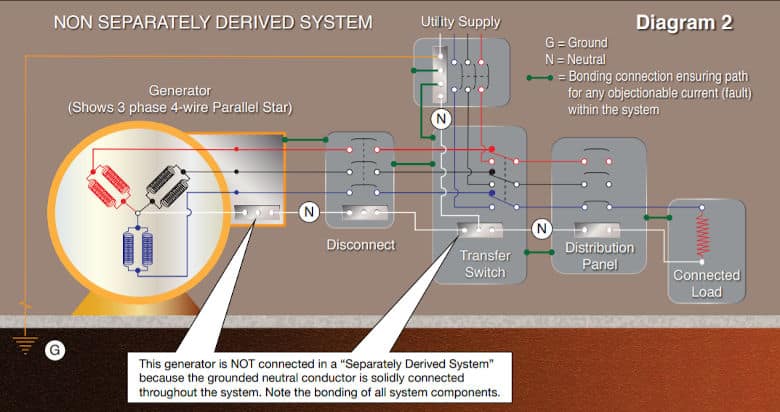Table of Contents
In the face of extreme weather changes ranging from tornadoes to hurricanes and blizzards, the grid is extremely vulnerable, and this means that blackouts are inevitable. This is what makes a portable backup generator an essential tool in any household’s power outage checklist. This must-have power backup solution kicks in during power interruptions making it possible to weather the storm until the grid is up again. However, as helpful as it could be, a generator can easily destroy your appliances and even cause death if mishandled.
In this article, we are going to discuss in detail one of the most crucial generator installation safety requirements: grounding. There is a lot of confusion around the matter of grounding a portable generator. For instance:
- Should all portable generators be grounded?
- Do I need a ground rod for a portable generator?
- How to properly ground a generator?
We cover all these and other questions in this write-up. Keep reading to find their answers.
What is grounding?
In electrical engineering, grounding refers to connecting an electrical circuit (the generator frame, in this case) to a reference point (the earth). Put in layman’s term, grounding a generator basically involves connecting its frame to the ground using solid copper wire and a grounding rod.
Do I need to ground my generator?
It is not always needed to ground your generator. Check its manual to see whether the generator needs grounding or not. Alternatively, you can check if the generator is a separately derived system.
- If it is, the generator will need to be grounded
- If it is not, you don’t need to ground it
To tell whether your generator is a separately derived system or not, check the transfer switch.
A generator that uses an unseparated derived system has a transfer switch that is not designed for transfer to the ground conductor. Consequently, you won’t need to connect it to a grounding rod.
Worth mentioning that in most portable generators today, the engine, fuel tank, and housing are attached to the frame. This eliminates the need for connecting the generator to a grounding rod. Still, check your generator’s manual to make sure that is so.
Why grounding my generator?
In order to understand why grounding a generator is important and what happens if you don’t ground a generator, we first need to understand how electricity moves from the generator to your appliances.
There are three wires that are involved in the movement of the electricity that is created in a generator:
- A live wire (50 Amp generators have two) – this is the line that carries the power from the generator to your appliances or transfer switch.
- Neutral wire– this wire completes the cycle by providing the electricity with a path back from the appliances.
- Ground wire– this wire is usually connected to the metallic frame of the generator and does not carry electricity. So, what is its importance?
Now, during the usable life of the generator, there is always the risk of the live wire insulation getting damaged. In case this happens so that the live wire touches the metallic frame on the damaged spot, there would be what we commonly refer to as a short circuit. At this time, the entire frame will now be HOT, and touching it may give you a nasty shock or even electrocution. That’s where the ground wire comes in.
If the generator is grounded correctly, any stray electrical currents that get to the frame are immediately directed to the earth via the low resistance ground wire. This makes the metallic frame safe to touch.
Besides the risk of electrocution, the faulty current may find its way into the engine or fuel tank causing fire or an explosion. In the worst-case scenario, this may not only lead to a damaged generator, but it might also lead to the destruction of property and deadly wildfires.
Grounding Requirements for Portable Generators

Most old generators require to be grounded regardless of how you’ll use it. On the other hand, most modern generators are safe to use without the grounding rod ONLY if they meet BOTH of the following generator grounding requirements stipulated by the Occupational Safety and Health Administration agency (OSHA):
- All the powered appliances must be connected directly to the receptacles mounted on the generator’s control panel. If you intend to plug in your devices into the generator receptacles, you won’t need to ground it. However, don’t proceed unless the next requirement has been fulfilled too.
- All the parts of the generator, including the fuel tank, combustion engine, and generator housing should be attached to the frame. In this case, the frame can take the place of the earth in taking care of the faulty currents.
Tools Needed to Ground a Generator
More often than not, most people think that grounding a portable generator is a complicated process that is perhaps best left to professionals. That’s not the case, though. Actually, chances are that you have pretty much everything that you’ll need for the job. All of them can also be easily found both online and from your local home improvement store.
Generator grounding tools you will need:
- Grounding rod– this is the most crucial component here. According to OSHA, this rod should be at least 8ft long and 5/8 inches in diameter.
- Solid copper grounding wire to connect the grounding rod to the generator frame. The wire gauge could vary between 6 AWG and 14 AWG depending on the voltage, the current, the circuit breaker at the generator and the length of the wire.
- A set of wire strippers– makes it easy to strip away copper wire insulation. A knife will do too.
- Pliers– to wind the copper wire around the grounding rod.
- Wrench– necessary for loosening and tightening the grounding screw on the generator frame.
- A hammer, sledgehammer, or mallet– to drive the grounding rod into the ground.
Optional tools:
- A shovel– this might be necessary in case you are dealing with rocky terrain.
- Water– may help in softening hard ground.
- Soldering iron and soldering wire (optional) – for attaching the copper wire to the grounding rod.
How to Ground a Portable Generator (Step by Step)
Here is a short video showing the process of grounding a generator:
- Start by installing the grounding rod
Depending on how hard the ground is, you may need to use a hammer, a mallet, or a sledgehammer to drive the rod into the earth. If you’re dealing with hard ground, softening it with water first may help a great deal.
Again, if there’s a rocky terrain that won’t allow you to drive the rod in, there is an option to dig a trench and bury the rod at an angle that doesn’t exceed 45 degrees. Note that if burying the rod is your only option, then the hole needs to be at least 30 inches deep.
- Connect the solid copper wire to the grounding rod
Next, take a set of wire strippers and remove a small part of the insulation on both sides of the solid copper wire. Take one side of the wire and wound it around the grounding rod. Soldering may be an easier option, too, if you have the necessary tools.
- Grounding the generator
With the copper wire already attached to the grounding rod, you are ready for the last step. Start by locating the grounding bolt on your generator. Use a wrench to loosen it just enough to be able to wrap the copper wire around it before tightening it again.
Conclusion
Safety comes first when dealing with electricity. Knowing how to ground a portable generator is one of the essential safety tips, especially if you plan to connect the generator to the transfer switch. This is a surefire way of ensuring that everyone, either at home or in the office, remains safe when dealing with the machine. It’s also the very first line of protecting your appliances.
If you intend to be moving around a lot with the generator, for instance, in camps or construction sites, one way of doing away with this whole process is to get a generator that does not require grounding.



2 thoughts on “How to Ground a Portable Generator – Requirements, Tools, Instructions”
Hi
Is it ok to leave the grounding rod in the ground indefinitely , then connect the grounding wire only when ready to fire the generator?
Hi Christopher,
Leaving the grounding rod in the ground is totally fine. Still, make sure to check it for corrosion or other damages from time to time. If the rod is severely corroded, it must be replaced.
If you have concerns about your grounding, I would advise contacting a licensed electrician.